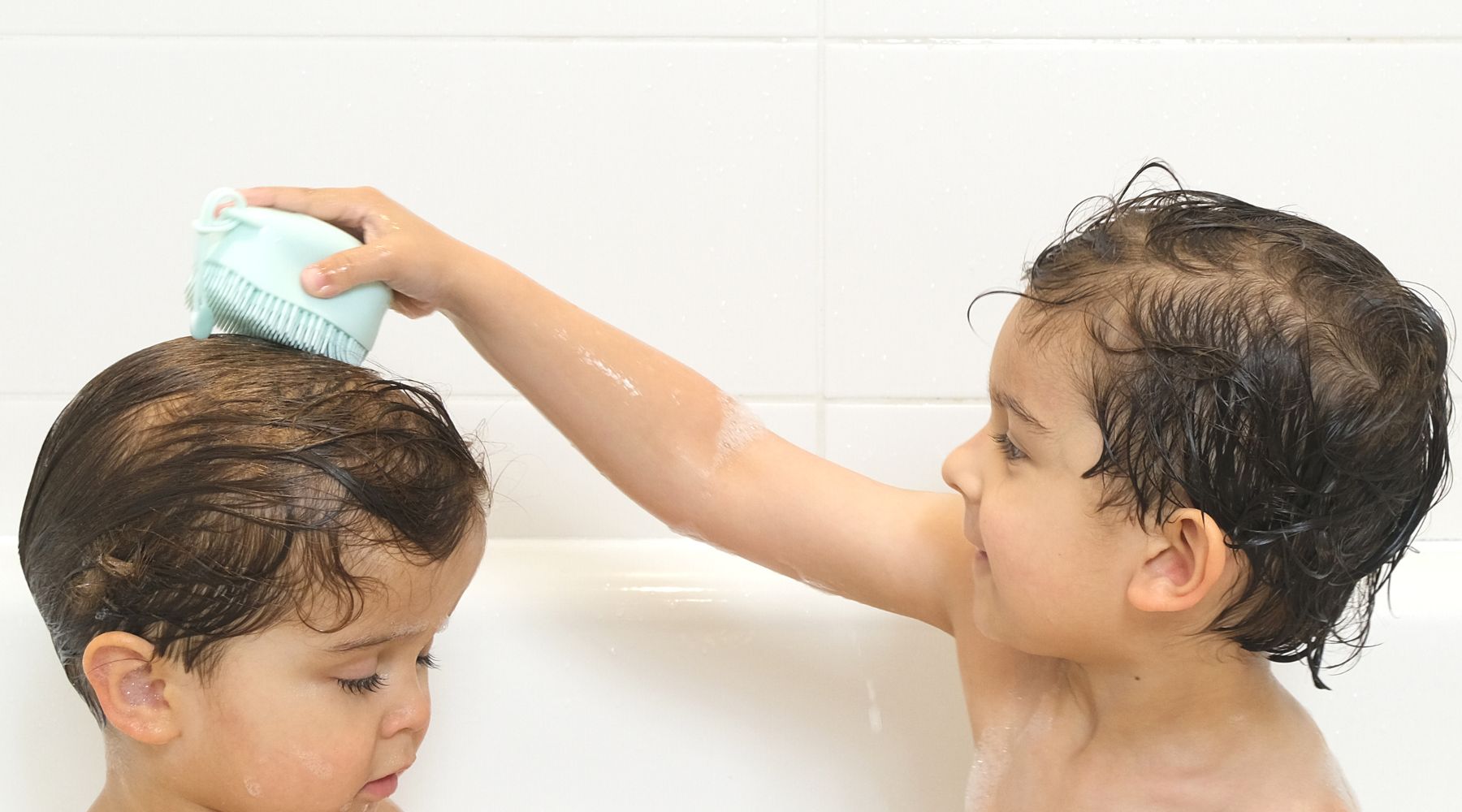How to wash your toddler's skin
Much like newborn baby skin, toddler’s skin is still developing and maturing. It is naturally more vulnerable than adult skin and needs looking after carefully. Unlike newborn baby’s though, they will be coming into contact with more of the world around them. Toddlers arte generally more exposed to the elements than babies – cold, cuts and scrapes, sweat and dirt all take their toll on toddler skin.
So looking after your toddler’s skin means finding the balance between keeping their skin well looked after, clean and well moisturised, while still treating it more gently than grown up kids and adult skin.

Toddler skin is different to adult skin
Toddlers' skin is significantly different from adult skin.
Toddler skin is much thinner and more delicate. Within the epidermis - outer layer of the skin – the strato corneum is approximately 5x thinner in young children than it is in adults. This makes it more susceptible to damage and irritation, as it lacks the protective barrier that adult skin has. The hydrolipidic film – the outer barrier of protection between your skin cells is also thinner which means it’s more permeable.
This higher degree of permeability in toddlers skin means it is more easily penetrated by substances, such as lotions and creams. This permeability allows for faster absorption of nutrients and moisture, which can be beneficial for maintaining healthy skin. But it also means that toddlers are more susceptible to the negative effects of harsh chemicals and irritants that may be present in certain products.
Toddlers also have different physiological properties than adult skin. Toddler skin has a higher water content, lower natural moisturising factors and a lower pH level, which makes it more prone to dryness and irritation.
Toddler skin also has a lower level of melanin, the pigment that gives skin its colour and helps to protect it from the damaging effects of the sun. As a result, toddlers' skin is more vulnerable to sunburn and other forms of sun damage as well.
It’s important to be aware of the unique characteristics of toddlers' skin and to take extra care in how you look after it.
You shouldn’t bath or wash your toddler too much

Our tendencies as adults to over-wash can carry through to our kids and that has some damaging effects on toddler’s skin. Dermatologist often warn that we over-bathe our young children and advise against frequent daily baths. Read more about how often you should bath your toddler here.
Over-bathing can strip the skin of its natural moisturising factors, which can lead to dryness and irritation. Natural moisturising factors are less prevalent in kids skin and because they’re water soluble, lots of bathing can lead to more of them dissolving into the water and drying out your toddler’s skin over time.
Dryness can also be caused if you are using harsh soaps or bubble baths that contain chemicals which will dry out your toddler’s skin. Toddler skin is thinner and more permeable so it is easier to absorb chemicals than adult skin, so frequent bathing where you’re adding bubble bath or thoroughly washing them can actually do more damage to the skin than good.
Over-bathing toddlers can also disrupt toddler’s natural skin microbiome, which is the collection of bacteria and other microorganisms that live on the skin. These microorganisms play an important role in maintaining healthy toddler skin and help to protect against infection and other skin irritations. Bathing too frequently, may remove some of these beneficial microorganisms, which can lead to an imbalance in the microbiome.
It is also worth noting that toddlers are still developing their immune systems, and frequent bathing may increase their risk of developing infections. The warm, moist environment of the bathtub can create an ideal breeding ground for bacteria. Sitting in the warm water or using an old sponge or wash cloth that hasn’t been disinfected can cause more skin infections.
Take the challenge of bathing your toddler less and using the right tools to wash them with to improve your toddler’s skin. Learn more about why you should not bath your toddler everyday here.
How to wash your toddler
1.Washing habits matter more than washing
Washing your toddler’s skin at bathtime or shower time is important to keep your child's skin clean and healthy. It removes dirt and sweat and prevents the build up of bacteria that make us sweat, but over time can also cause skin irritation.

But that habit of washing is more important at that young age than making sure they are fully scrubbed. Personal hygiene habits are an important part of maintaining good health as your toddler grows up, so teaching your toddler to wash their hands, face, and other parts of their body regularly is an important part of growing up. At GRASP we believe these habits will not only help ensure your toddler is clean and healthy as an adult, but their self-sufficiency will also help them feel more confident throughout their childhood.
Instead of focusing on making sure your toddler is as clean as possible, focus instead on helping them develop the independence and confidence they need to take care of themselves as they grow and develop. Helping develop the skills to wash themselves, and making bathtime more fun so they develop a love of looking after themselves is the best thing you can do for your toddler.
2. Use less skincare product to better protect your toddler’s skin.
As parents, we all get concerned about using the best products for our little one's skin. But actually, using fewer skincare products when washing your toddler at bathtime can be overlooked.

Not every bathtime needs to include a skincare product, sometimes a rinse is enough. Minimising the use of bubble baths or using just a small amount of skincare to wash body and hair can do your toddler’s skin more good over time.
Toddlers have delicate skin that is still developing, and exposing it to too many chemicals or synthetic ingredients can potentially disrupt this development. By using fewer skincare products, you can help reduce the overall load on your child's skin and allow it to function naturally. Using fewer products can help minimize the risk of irritation, dryness, and other adverse reactions.
Choose an inexpensive natural skincare product and stick with it. Avoid SLS and use it sparingly when you’re washing your kid’s skincare.
Read more about the best skincare essentials to use on your toddler’s skin.
3. Even your toddler’s delicate skin needs gentle exfoliation
Exfoliating your skin helps remove dead skin cells, unclog pores, and improve the overall texture and appearance of the skin. While it is important to be gentle when exfoliating the skin of a young child, it can still be beneficial to include some form of exfoliation when washing them.

It is important to be careful when exfoliating the skin of a toddler, as their skin is more delicate than that of an adult and the thinner outer layer of skin is more easily damaged. Use a gentle exfoliator such as a mild silicone scrub, wash cloth or sponge specifically designed for baby skin. Use a very light touch and do not to exfoliate too frequently (fewer baths is better anyway), as over-exfoliating can lead to irritation and other adverse reactions.
How to use the Pebbl silicone scrub to wash your toddler’s skin

- Open Pebbl silicone cap by pulling the tab and pour in a little of your preferred soap into the brush cavity. – probably slightly less than you would usually.
- Once you’ve added your soap, add a little water by dipping the brush quickly in the bath or holding it, cap open, under the water as the shower is running. It doesn’t need to be a lot of water, just enough to get the lather of your soap going.
- Now it’s filled with a little soap and water, give your brush a shake then give Pebbl a gentle squeeze on the sides of the brush while you hold the scrubber in the palm of your hands to release the foam and lather onto the silicone bristles.
- Once you’ve got the brush activated, pass it to your kids – attach the wrist strap if you want – and let them get to work scrubbing. As they squeeze and scrub all over the soapy suds will be slowly released onto their skin and scalp.
- Once your kids have finished washing. Uncap the brush give it a little rinse out and then hang it up to dry.

Read the complete guide on how to use a silicone scrub to wash your toddler's skin.

























Leave a comment